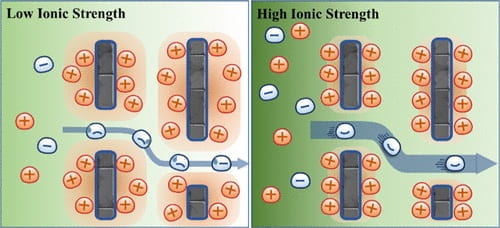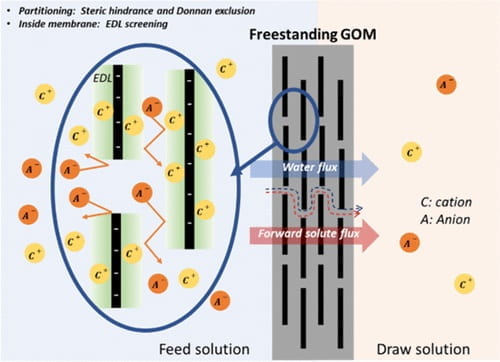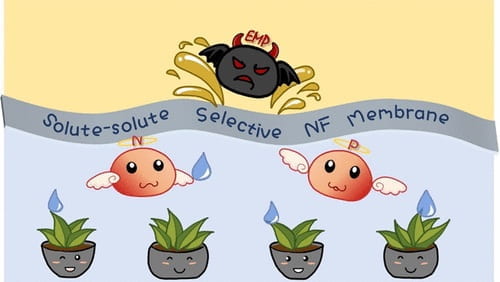
Gao, H., Zhong, S., Zhang, W., Igou, T., Berger, E., Reid, E., Zhao, Y., Lambeth, D., Gan, L., Afolabi, M., Tong, Z., Lan, G., & Chen, Y. (2021). Revolutionizing membrane design using machine learning-bayesian optimization. Environmental Science & Technology, 56(4), 2572-2581.
This study employed machine learning (ML) with Bayesian optimization for polymeric membrane design, overcoming the challenges of traditional trial-and-error approaches. The ML models used information like the Morgan fingerprint to predict membrane performance, such as water permeability and salt rejection. By applying Bayesian optimization to these ML models, optimal monomer combinations and fabrication conditions were identified. Eight membranes created using these specifications outperformed current benchmarks, showcasing the potential of ML in revolutionizing membrane design. Learn more

Cohen, A. R., Chen, G., Berger, E. M., Warrier, S., Lan, G., Grubert, E., Dellaert, F., & Chen, Y. (2021). Dynamically controlled environment agriculture: Integrating machine learning and mechanistic and physiological models for sustainable food cultivation. ACS ES&T Engineering, 2(1), 3-19.
This study addresses challenges in urban controlled environment agriculture (CEA) related to precise input control. Existing plant growth models (MPMs) have limitations when applied to diverse species or conditions. While machine learning (ML) can identify hidden patterns, its application is limited by phenotyping challenges. The study suggests combining MPMs and ML to create dynamically controlled environment agriculture (DCEA), using MPMs as a foundation for ML algorithms. This integrated approach can enhance urban agriculture, improve productivity, and ensure nutritional quality. Learn more

Yan, L., Gao, H., & Chen, Y. (2021). Na-doped graphitic carbon nitride for removal of aqueous contaminants via adsorption and photodegradation. ACS Applied Nano Materials, 4(8), 7746-7757.
The study focuses on enhancing the capabilities of graphitic carbon nitride (g-CN) as a photocatalyst. Sodium-doped g-CN (Na(x)-CN) was created using a one-step pyrolysis method, mixing melamine and sodium carbonate. This modified g-CN showcased greatly improved adsorption capabilities, particularly for methylene blue, due to enhanced π–π and electrostatic interactions. Additionally, the sodium carbonate-aided synthesis improved the material’s optical properties and efficiency in separating photocarriers, promoting better contaminant removal through photodegradation. This research offers a simple method to produce improved g-CN with enhanced adsorption and photocatalytic performance. Learn more

Tong, X., Liu, S., Zhao, Y., Chen, Y., & Crittenden, J. (2021). Influence of the exclusion-enrichment effect on ion transport in two-dimensional molybdenum disulfide membranes. ACS Applied Materials & Interfaces, 13(23), 26904-26914.
This research delves into ion transport within 2D molybdenum disulfide (MoS2) nanosheet membranes, commonly used in water treatment. By merging experiments with numerical models, the study examines how the electrical double layer (EDL) impacts ion diffusion. A novel parameter, the exclusion-enrichment coefficient (β), gauges the electrostatic interaction between coions and EDL. Findings indicate that coion diffusion can be slowed in the membrane. The study further explores mechanisms via theoretical estimations, noting convective transport’s influence on β. Potential applications and membrane designs for 2D nanosheets are proposed. Learn more

Xu, C., & Chen, Y. (2021). Understanding water and solute transport in thin film nanocomposite membranes by resistance-in-series theory combined with Monte Carlo simulation. Journal of Membrane Science, 626, 119106.
The study addresses the limited understanding of water and solute transport in thin film nanocomposite (TFN) membranes used in water treatment. A new model was developed to assess the impact of nanoparticles (NPs) and their interaction with the polymer layer on TFN membrane performance. Results show that even minimal NP addition can boost flux due to various factors. Optimal NP configurations and minimized aggregation can achieve higher permeate flux. The findings can guide the design of improved TFN membranes, balancing permeate flux and rejection. Learn more

Liu, S., Tong, X., Chen, Y., & Crittenden, J. (2021). Forward solute transport in forward osmosis using a freestanding graphene oxide membrane. Environmental Science & Technology, 55(9), 6290-6298.
The study investigates the potential of graphene oxide membranes (GOM) for forward osmosis (FO) in water treatment, given its high water permeability and low reverse salt flux. Examining both charged and uncharged solutes, the research uses the Donnan steric pore model to calculate solute flux. Results reveal GOM’s superior separation of multivalent ions compared to monovalent ones. Discrepancies between experimental and calculated solute flux values indicate an electrical double layer’s influence on ion transport. The findings offer insights for future GOM applications in FO treatments. Learn more

Tong, X., Liu, S., Crittenden, J., & Chen, Y. (2021). Nanofluidic membranes to address the challenges of salinity gradient power harvesting. ACS nano, 15(4), 5838-5860.
This review focuses on the potential of Salinity Gradient Power (SGP) as a renewable energy source, harvested using membrane-based technologies like Reverse Electrodialysis (RED) and Pressure Retarded Osmosis (PRO). The study delves into the benefits of nanofluidic membranes in enhancing power generation and examines how membrane properties impact power density. It underscores the importance of system energy efficiency and highlights research on antifouling nanofluidic membranes. The review concludes by emphasizing the potential of SGP in large-scale renewable energy applications with high-performance membranes. Learn more

Gao, H., Wang, Y., Afolabi, M. A., Xiao, D., & Chen, Y. (2021). Incorporation of cellulose nanocrystals into graphene oxide membranes for efficient antibiotic removal at high nutrient recovery. ACS Applied Materials & Interfaces, 13(12), 14102-14111.
The study focuses on developing laminated graphene oxide (GO)–cellulose nanocrystal (CNC) hybrid membranes for wastewater treatment. These hybrid membranes combine the unique properties of both materials, resulting in enhanced hydrophilicity, surface structure, and increased water permeability. The optimized GO/CNC membrane efficiently filters out typical antibiotics while permitting beneficial nutrients. The membrane’s antibiotic removal mechanism involves electrostatic repulsion and adsorption. This hybrid approach offers a promising strategy for advanced water purification and resource recovery. Learn more

Pei, X., Gan, L., Tong, Z., Gao, H., Meng, S., Zhang, W., … & Chen, Y. (2021). Robust cellulose-based composite adsorption membrane for heavy metal removal. Journal of Hazardous Materials, 406, 124746.
The study introduces an adsorptive membrane designed to remove heavy metals from water, overcoming issues of instability and low affinity. Using a regenerated cellulose base, polyelectrolyte active layers are covalently bonded to the membrane through a layer-by-layer assembly method. This approach offers improved stability and adjustable water flux. Tested for Cu, Pb, and Cd removal, the membrane has a high adsorption capacity (up to 194 mg/g), performs best at lower metal concentrations and higher pH, and is easily regenerated. Learn more

Tong, X., Liu, S., Qu, D., Gao, H., Yan, L., Chen, Y., & Crittenden, J. (2021). Tannic acid-metal complex modified MXene membrane for contaminants removal from water. Journal of Membrane Science, 622, 119042.
The study focuses on enhancing 2D MXene membranes for water treatment by coating them with a tannic acid (TA)-metal complex layer. This modification leads to reduced pore size, increased surface hydrophilicity, and improved membrane selectivity, allowing high water permeability, low salt ion rejection, and significant contaminant removal, including hydrophobic micropollutants. The DLVO theory helps understand the interaction energy between contaminants and the membrane. This advancement presents a potential solution for drinking water purification and wastewater reuse. Learn more

Zhao, Y., Tong, X., & Chen, Y. (2021). Fit-for-purpose design of nanofiltration membranes for simultaneous nutrient recovery and micropollutant removal. Environmental Science & Technology, 55(5), 3352-3361.
The study introduces a novel thin-film composite membrane designed to selectively filter emerging micropollutants (EMPs) from domestic wastewater while retaining valuable nutrients like nitrogen and phosphorus. By using a combination of polyethylenimine, piperazine, and surfactant in the fabrication process, the membrane’s pore characteristics and charge were optimized. This led to efficient separation between EMPs and nutrients. The study also applied a modified filtration model to explain the membrane’s selectivity, highlighting its potential for wastewater resource recovery. Learn more

Zhao, Y., Tong, T., Wang, X., Lin, S., Reid, E. M., & Chen, Y. (2021). Differentiating solutes with precise nanofiltration for next generation environmental separations: a review. Environmental Science & Technology, 55(3), 1359-1376.
This critical review emphasizes the need for membranes with precise selectivity in water purification and resource recovery. Addressing environmental challenges necessitates refining solute–solute membrane selectivity. The review delves into the mechanisms behind improved selectivity, the importance of tailored membrane structure, and recent advancements in material design. Special attention is given to surface engineering, nanotechnology, and molecular design as key approaches. It concludes by discussing practical challenges and future research directions for harnessing highly selective membranes for environmental sustainability. Learn more

